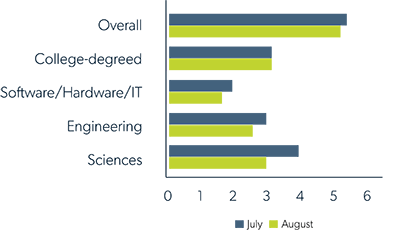Actalent's Economy and Labor Market Brief: August 2021
Actalent's August 2021 Jobs Report synthesizes information from a variety of sources including the United States Bureau of Labor Statistics survey results, media reports, industry intelligence, company earnings reports, and external labor market data. The full set of data is included as a companion to this article.
August's Labor Market Top Takeaways:
- The engineering and sciences talent drought continues to spark: many labor categories continue to have far greater vacancies with far fewer candidates to fill them.
- Overall job gains fell short of economists' predictions; however, job gains in engineering and sciences held steady.
- Unemployment rates continue to drop in several engineering and sciences categories (e.g., Life, Physical, and Social Sciences unemployment rate dropped from 3.9% to 3.0% between July and August).
- Job quits reached near record highs.
Let's take a more in-depth look at the data that's informing these takeaways. We'll start with an overall, high-level review before a taking a more focused look at Actalent's engineering and sciences labor categories.
Overall Jobs, Labor Force Participation, and Unemployment Rates
- 235K jobs were gained in August, falling short of economists' expectations of 720K and largely attributed to uncertainty regarding COVID-19.
- 3M fewer people are working or looking for work as compared to pre-pandemic levels. At 61.7%, the labor participation rate remains unchanged from July and still well below pre-pandemic participation rate levels (63.3% in February 2020).
- The overall unemployment rate was 5.2% in August, a slight decrease from July's 5.4% rate.
- The unemployment rate for four-year college degreed individuals remained at 3.1%.
- The rate falls even lower for Actalent labor categories in engineering and sciences, more details found below.
- 3.97M workers quit their job in July, an increase over June's 3.86M job quits.
A Look at Engineering and Sciences Labor Market Data
Engineering and sciences unemployment rates remain significantly lower than the overall national average:

Software-Hardware-IT + Mathematics: unemployment dropped from 2.0% in May-July to 1.7% in June-August
Architecture + Engineering: unemployment dropped from 3.0% in May-July to 2.7% in June-August
Life, Physical, + Social Sciences: unemployment dropped from 3.9% in May-July to 3.0% in June-August
Demand for engineering and sciences workers continued to increase over the past month:
- Automotive Manufacturing added 24.1K jobs, an increase of 3.7% over July
- Scientific R+D Services added 7.4K jobs, an increase of 9.1% over July
- Architectural + Engineering Services added 18.7K jobs, an increase of 5.3% over July
Other Important Considerations Making Headlines
The Impact of Hybrid and Remote Work on Talent Access. Wider adoption of remote work has companies competing for talent on a global stage in nearly every market. And with more and more workers indicating a preference for hybrid or remote work, the talent war is now geographically unbound. In fact, a late-August Conference Board Survey found 67% of workers preferred hybrid work environment, versus 4% who preferred an in-person only environment. In the same survey, 89% of job seekers indicated flexible work arrangements was an important consideration in their decision to find a new job.
Vaccination Mandate. Last week, the Biden Administration announced a federal mandate, enforced through OSHA, that requires vaccination or weekly testing for all companies with more than 100 employees, or face a $14,000 fine for each violation. Several states are pursuing legal action to reverse the mandate. While it remains to be seen how the mandate will be implemented and how the labor force will respond, it is expected to affect nearly 80 million workers, or 2/3 of the US workforce.
Harvard Business Review's Recent Insights on Why So Many Are Missing from the Labor Force. While SARS-CoV-2 and its variants have significantly impacted labor force participation rates, a recent study titled “Hidden Workers: Untapped Talent” by HBR introduces other factors that have companies missing out on potential talent, including rigid automated hiring systems. That's right: their research uncovered inflexible automated systems that auto-eliminate potential great fitting candidates based on inflexible requirements such as keywords or unexplained job gaps, making it difficult for candidates to stand-out.
Implications and Next Steps for Businesses
- Invest in and engage the talent you already have. Given current market conditions, combined with existing scarcity of engineering and sciences talent, the care and engagement of employees is no longer a nice-to-do. Soliciting regular feedback regarding employees' needs and career goals, and then following up on what's learned is an important first step. Check-in with employees regularly, know what's important to them, and offer consistent recognition and feedback.
- Consider offering flexible work options. What a year it's been—and many companies' long-term plans for digital transformation were accelerated as the world shut down. But for all the things we lost these past 18-months, productivity was not among them. Employees rose to the occasion and showed us what was possible. As restrictions loosen and offices open, continuing to offer flexible work options acknowledges the trust you have in your employees to work hard wherever they are, the variety of needs and circumstances that exist, and practices that engage them.
- Consider creative solutions for attracting talent, including upskilling opportunities. Related to the investment and engagement of existing employees, and the reality that skills-in-demand are shifting, companies are beginning to invest in reskilling and upskilling programs for their employees. Just as the digital transformation has eased geographical restriction for hiring, it's also widened the possibilities for career changes and shifts. Another example of how engaging your employees, understanding their career goals and aspirations, and considering creative solutions when challenges arise builds a culture that's ready for anything—and will succeed.
- Examine the process used to identify and attract candidates. While automation has expedited and improved the process for many things in engineering and sciences, hiring may not be among them. And given this highly competitive, automated climate, it may be time to shelve the software and get back to a more human-centered approach to hiring. Actalent consultants repeatedly remark on the personalization of our hiring process—software and algorithms have nothing on our recruiters' ability to find the right people to solve our clients' important problems.
If you'd like more information on the data presented, or have questions about the information provided in this report, please contact our team at: content@actalentservices.com.



